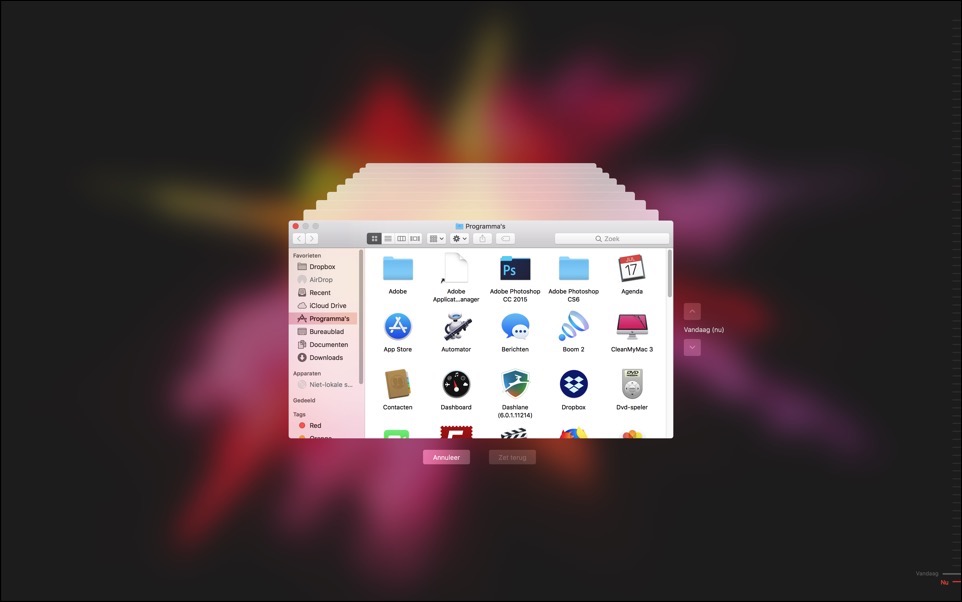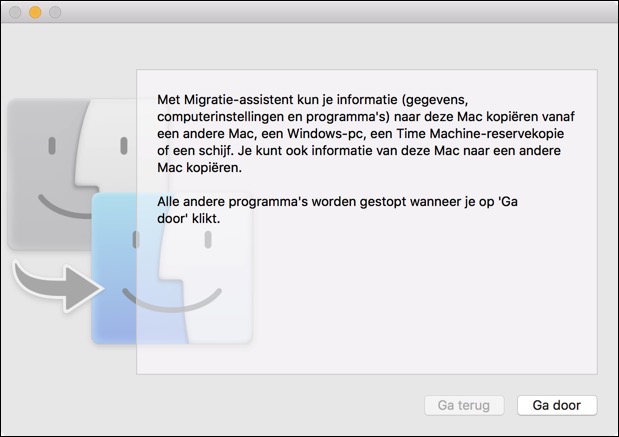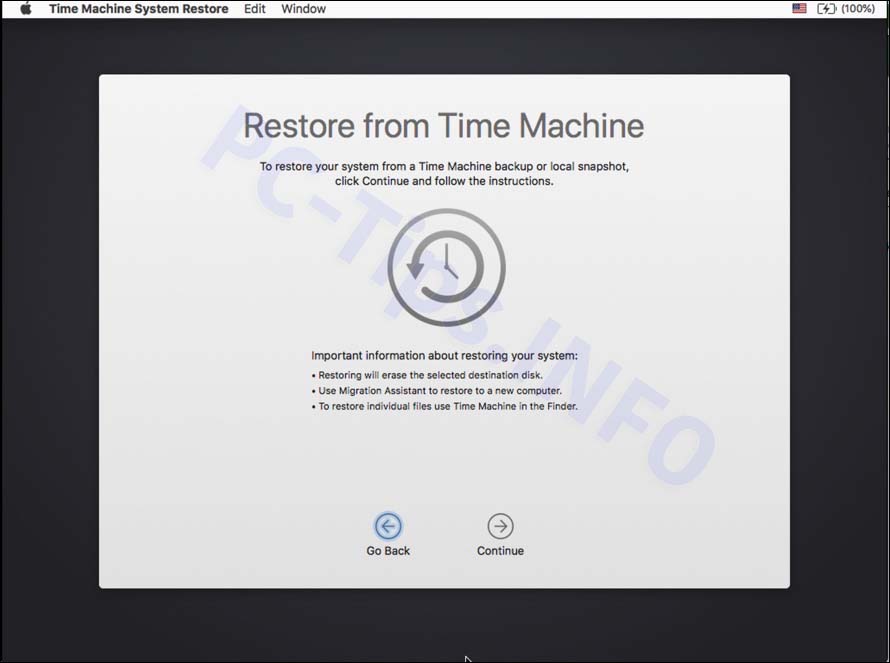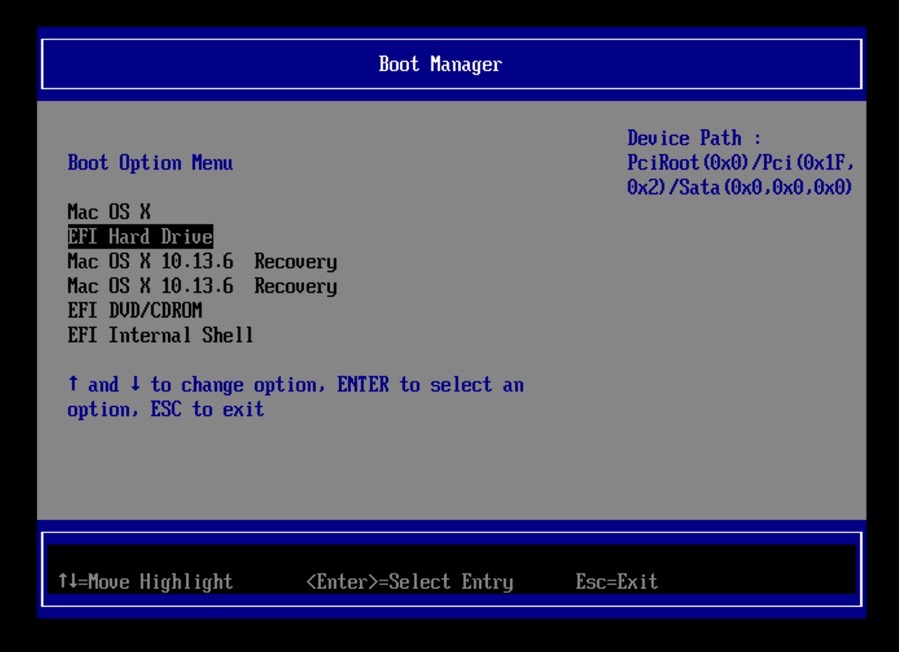Apple introduced Time Machine together with macOS Leopard. The Time Machine software backs up your Mac's operating system, including all files, folders, system preferences, installed Mac programs, and more.
Time Machine should be enabled on every Mac computer because it is one of the easiest methods to protect your data in case your operating system or internal storage has failed.
De time Machine backup is useful when you are considering replacing the hard drive. Moreover, this software can also help transfer data between separate Mac computers.
Apple's Time Machine saves the back-up data to an external storage device, and works with all possible connections, including USB, FireWire, and Thunderbolt. Time Machine also supports Time Capsule and backup drives connected via the internal network.
Time Machine periodically takes a snapshot of all your data and applications and stores them in external memory. The snapshots are taken hourly, daily and weekly. As you can imagine this will take up a lot of free space, Time Machine automatically deletes the oldest backup files and replaces them with the most recent backup.
Time Machine always leaves about twenty percent of the free space available. One of the biggest advantages of this software is that it is possible to recover only some specific missing files. This way you don't have to restore the entire operating system.
This is in contrast to a lot of other backup software. In addition, if you have a Apple using a laptop running OS X Yosemite or later. Then Time Machine has another feature called Local Snapshots. A backup is then made to the Mac's internal memory while your Time Machine drive is not connected. In this article, we discuss the methods for recovering files from a Time Machine snapshot and full system backup.
Restore damaged or missing files from a Time Machine backup
If you have enabled Time Machine, you will be able to recover all files. This function can save you a lot of time if, for example, you have deleted or overwritten a file.
Time Machine stores the current version of each file. To retrieve files saved in snapshots, first launch the Time Machine application through Spotlight, press the keyboard combination Command + Spacebar and type: Time Machine.
You can also go to the Applications folder via Finder to launch the Time Machine application. When the application launches, you can browse the list of backups sorted from oldest to newest by clicking the up and down arrows on the screen.

When you find the file you are looking for, select the file and press the spacebar to preview it.
When you are sure this is the correct file, click Restore. If you cannot see the snapshot, first click the Cloud icon to download the current snapshot.
You can then search for and restore files from that specific snapshot. Even if the Time Machine external storage is not connected to your computer. If you are looking for some information from the text file, you can simply select the copy/paste function and use it to restore only the required (selected) lines.
Transfer files with Time Machine
As mentioned above, Time Machine backups can be useful in several situations. Despite the possibility of restoring the previous version of your files or completely restoring the system, transferring your data from one Mac computer to another can help.
For example, if your old Mac stops working and you want to set up the newly purchased Mac, the external storage with the Time Machine backups very handy to transfer all favorite programs, calendar appointments, etc.
However, if both of your Macs still work, you may want to consider using Migration Assistant.
The Migration Assistant allows you to automatically transfer data from one Mac to another Mac. Moreover, this application also works with Time Machine backups. If you want to stay with the latest version of the operating system but get all the data back from your old Mac computer, Migration Assistant will add all the contents of Time Machine's backups to your new Mac.
To transfer content from backups using Migration Assistant, first connect your external storage to the Time Machine backup.
Then launch Spotlight, press the keyboard command + spacebar and type: Migration assistant.

Once the Migration Assistant starts, click Continue, then select the data from a Time Machine backup and click Continue again.
The migration assistant asks for your password. Enter your administrator password and a list of all existing backups in chronological order will appear.
Choose the most recent one or another one you wish to use and click Continue. The migration assistant will start copying your data. This depends on the size of the backup and the speed of both the external storage and the internal hard drive, this process can take anywhere from several minutes to several hours.
Restore operating system from Time Machine backup
To completely restore your operating system from a Time Machine backup, you'll need to enter macOS recovery mode. This is one of the easiest way to restore your operating system to an earlier version. It can also be an efficient solution if your computer's software is struggling. In addition, restoring the entire operating system helps if your computer becomes infected with a virus or malware.
To access the Recovery menu, connect your external storage and shut down your Mac. Restart your Mac and hold down Command + R as it starts up. The Mac will now start in recovery mode. Keep this key pressed until Applelogo appears, release these keys and wait for the macOS utilities to appear. From the list of options, choose Restore from Time Machine Backup and click Continue.

Then select the volume containing your backup file and then select the backup file by sorted date & time and version of macOS. When the process is completed, your Mac will restart automatically.
Start your Mac from the Time Machine backup
Starting your computer from the Time Machine backup can be helpful when trying to troubleshoot your computer's problems. If you're not sure if your operating system is experiencing problems, you can test it by booting your computer from the Time Machine backup. To boot your Mac with Time Machine backup, shut down your computer, then hold down the Option (Alt) key to open the Boot Manager screen and choose EFI as the startup disk.

Hopefully this instruction helped you. Thank you for reading!


How do I activate Time Machine to make a backup?
Hello Jan, here you can read how to enable and use time machine: https://support.apple.com/nl-nl/HT201250
Kind regards, Stefan